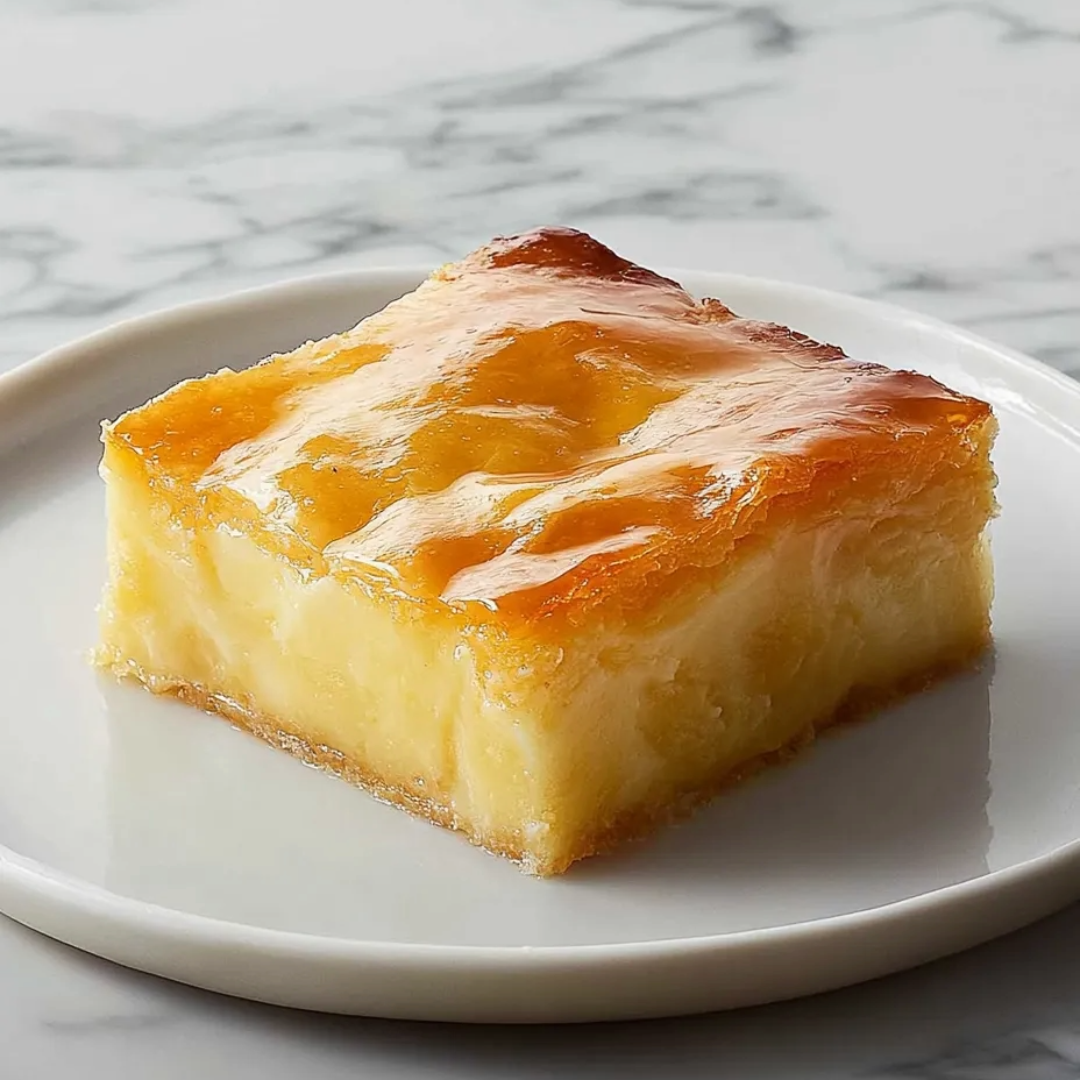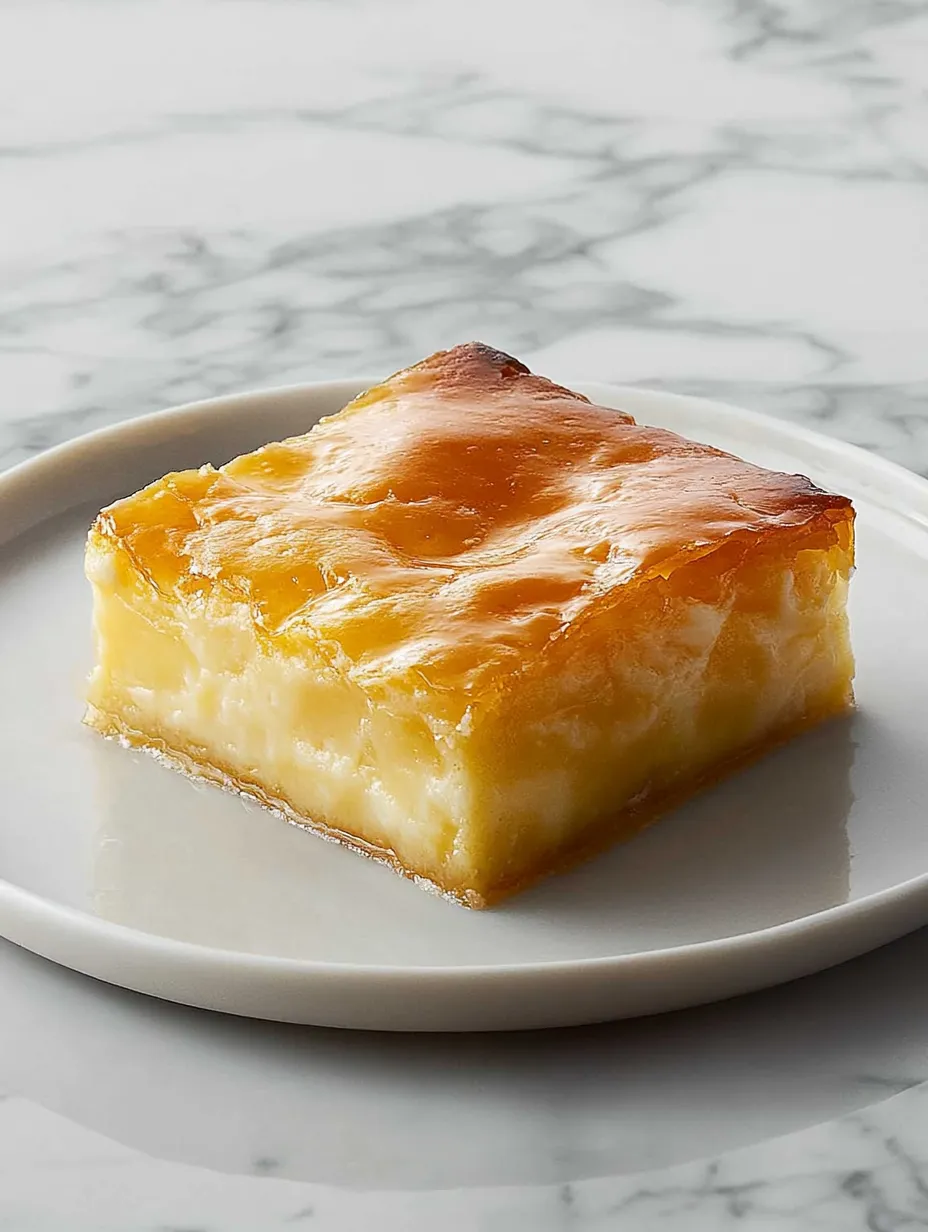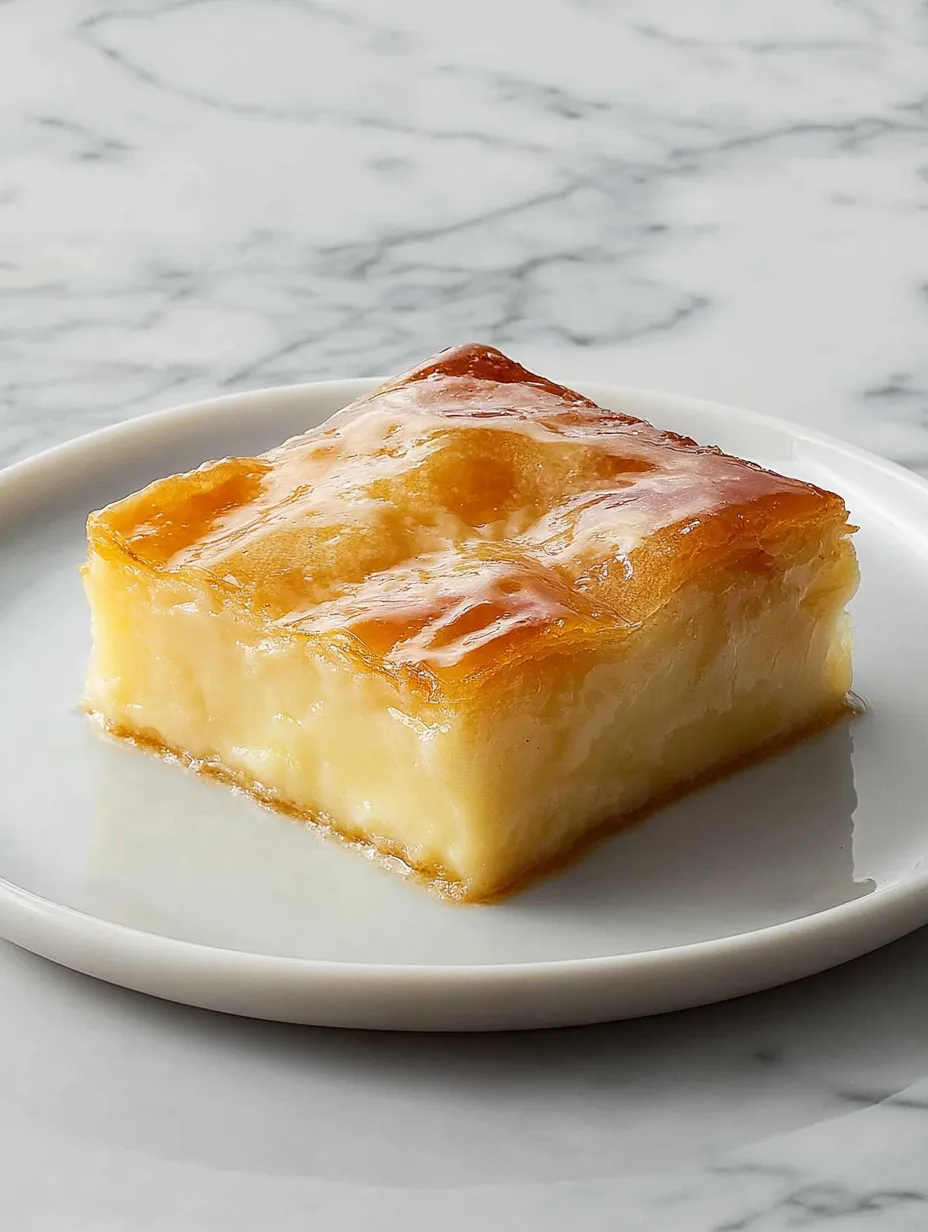 Pin it
Pin it
This magnificent Greek Galaktoboureko combines crispy, buttery layers of filo pastry with a silky semolina custard that's soaked in a fragrant honey-lemon syrup. Unlike many custard desserts, this one sets firmly enough to slice beautifully, while still maintaining a creamy, melt-in-your-mouth texture. I've perfected this recipe through multiple tests to capture the authentic flavor of my Yiayia's traditional version, with a few tweaks to ensure it holds its shape when served.
The first time I served this at a family gathering, even my Greek relatives were impressed by how closely it resembled the traditional version they remembered from their childhoods. There's something magical about the contrast between the crisp filo exterior and the smooth, sweet custard center that makes this dessert truly unforgettable.
Ingredients
- 2 cups granulated sugar: Creates the sweet base for our syrup. You can also use caster sugar if preferred.
- 1½ cups water: Dissolves the sugar and creates the right consistency.
- 2 tablespoons honey: Adds depth of flavor and helps prevent crystallization.
- 1 lemon: You'll use both the peel (in strips, not grated) and juice for bright, citrusy notes.
- 1 cinnamon stick: Infuses the syrup with warm, aromatic flavor.
 Pin it
Pin it
For the Semolina Custard:
- 6 cups whole milk: Provides richness and the foundation for our custard. Full-fat milk is essential here.
- 1 cup heavy cream: Creates an extra silky, luxurious texture that elevates the custard.
- 1 cup fine semolina: This is the star ingredient that gives the custard its unique texture. Be sure to use fine semolina (sometimes labeled semolina flour), not the coarse version.
- ¼ cup cornstarch: Helps thicken the custard without requiring too many eggs, preventing an overly eggy flavor.
- 1 cup caster sugar, divided: The superfine texture dissolves easily into our custard.
- ½ cup unsalted butter: Adds richness and helps create that luscious mouthfeel.
- 2 teaspoons vanilla extract: Provides aromatic sweetness that enhances all the other flavors.
- 6 large eggs, room temperature: Binds the custard and contributes to its firm yet creamy texture.
For Assembly:
- 1 pound (about 20 sheets) filo pastry: Creates those signature crispy layers. Look for it in the freezer or refrigerated section of your grocery store.
- 1 cup clarified butter: Using clarified butter instead of regular melted butter prevents burning and keeps the pastry crisp.
Step-by-Step Instructions
Day 1:
- Make the syrup:
- Combine the sugar, water, honey, lemon peel strips, lemon juice, and cinnamon stick in a medium saucepan. Bring to a boil over medium heat, then reduce to a simmer and cook for 5 minutes, stirring occasionally. Remove from heat and let cool completely. Once cool, remove the cinnamon stick and lemon peels with a fork. The syrup must be completely cool before using.
- Prepare the custard base:
- In a small bowl, whisk together the fine semolina and cornstarch until well combined. In a large, heavy-bottomed pot, combine the milk, half the sugar (½ cup), and the butter. Heat over medium, stirring frequently, until it almost reaches a simmer.
- Cook the semolina mixture:
- Once the milk mixture is hot but not boiling, slowly add the semolina-cornstarch mixture while whisking constantly to prevent lumps. Continue to cook, stirring continuously with a wooden spoon, until the mixture thickens significantly and begins to bubble gently, about 5-7 minutes. The consistency should resemble thick porridge.
- Cool the custard:
- Transfer the hot semolina mixture to a large bowl. Press a piece of plastic wrap directly onto the surface to prevent a skin from forming, and allow it to cool to room temperature, about 30-45 minutes.
- Prepare the egg mixture:
- Once the semolina mixture has cooled, beat the eggs, remaining ½ cup of sugar, and vanilla extract in a large bowl using an electric mixer. Beat on high speed until the mixture becomes pale, thick, and voluminous, about 5-8 minutes. This step is crucial for the texture of the final custard.
- Combine the mixtures:
- Gently fold the whipped egg mixture into the cooled semolina mixture using a rubber spatula. Take care to maintain as much air as possible while ensuring everything is evenly incorporated. The result should be a smooth, pourable custard.
- Assemble the pie:
- Preheat your oven to 350°F (175°C). Brush the bottom and sides of a 9×13-inch baking dish with clarified butter. Begin layering the filo sheets, brushing each one with clarified butter before adding the next. For the bottom layer, use about 10 sheets of filo, allowing them to hang over the edges of the dish.
- Add the filling:
- Pour the custard mixture over the filo layers and spread it evenly. Fold the overhanging filo over the custard, then layer the remaining 10 sheets on top, brushing each with clarified butter.
- Score and bake:
- Using a sharp knife, score the top layer of filo into your desired serving pieces, cutting just through the top filo layers but not into the custard. This makes serving easier later. Bake in the preheated oven for 45-50 minutes, until the pastry is golden brown and crisp.
- Add the syrup:
- As soon as the galaktoboureko comes out of the oven, immediately pour the cold syrup evenly over the hot pastry. You'll hear it sizzle – that's good! It means the hot pastry is absorbing the cold syrup.
- Let it rest:
- Allow the pie to cool completely at room temperature, then cover and refrigerate overnight. This resting period is essential for the custard to fully set and the flavors to meld.
Day 2:
- Serve and enjoy:
- The next day, cut along the scored lines and carefully lift out pieces to serve. The custard should be firm enough to hold its shape while still being creamy and luscious.
The Science of Semolina Custard
What makes galaktoboureko unique among custard desserts is the use of semolina. Unlike cornstarch-thickened custards or egg-based custards, semolina creates a texture that's simultaneously creamy and structured. The tiny grain particles absorb liquid as they cook, swelling and creating a pudding-like base. Combined with eggs, which set when heated, the result is a custard that's firm enough to slice but still melts in your mouth.
The Importance of Overnight Setting
While it might be tempting to dig in while this dessert is still warm, the overnight refrigeration is non-negotiable. This resting period allows three important things to happen:
- The custard fully sets to a sliceable consistency
- The syrup distributes evenly throughout the pastry and custard
- The flavors meld and develop, resulting in a more complex taste profile
Serving Suggestions
Galaktoboureko is typically enjoyed on its own, but a few simple accompaniments can enhance the experience:
- A small scoop of vanilla ice cream
- A sprinkle of ground cinnamon
- A dollop of unsweetened whipped cream
- Fresh berries for a colorful contrast
I learned through trial and error that the egg-whipping stage is absolutely crucial. My first attempt used eggs that weren't beaten long enough, resulting in a dense, heavy custard. When properly whipped to a pale, thick consistency, the eggs create a significantly lighter, more ethereal texture in the final dessert.
 Pin it
Pin it
After making this dessert countless times, I've discovered that adding the heavy cream (which isn't always included in traditional recipes) creates a noticeably silkier, more luxurious custard. It's a small addition that makes a significant difference in the final texture, resulting in a galaktoboureko that's both authentic and refined.
This Greek Galaktoboureko requires a bit of time and patience, but the results are absolutely worth the effort. The combination of crispy, buttery filo and smooth, aromatic custard creates a dessert that's impressive enough for special occasions but comforting enough to remind you of home. Whether you're Greek or simply appreciate incredible desserts, this recipe will become a treasured addition to your collection.
Frequently Asked Questions
- → What is semolina and can I substitute it?
- Semolina is a coarse flour made from durum wheat, giving the custard its distinctive texture. For authentic Galaktoboureko, fine semolina is essential and can't be easily substituted. Look for it in the baking aisle of your supermarket.
- → Why is my filo pastry breaking or drying out?
- Filo dries out quickly when exposed to air. Keep unused sheets covered with a slightly damp kitchen towel while working. If using frozen filo, thaw it overnight in the refrigerator, not at room temperature, which can make it brittle.
- → Why pour cold syrup over hot pastry?
- This technique is crucial for the perfect texture - pouring cold syrup over hot pastry helps maintain the crispness of the filo while allowing it to absorb just enough syrup without becoming soggy.
- → Can I make Galaktoboureko ahead of time?
- Yes, you can prepare it a day ahead. It's actually delicious served chilled from the refrigerator the next day. It will keep for up to three days, though the pastry is crispiest within the first 48 hours.
- → What's the best way to serve this dessert?
- Galaktoboureko can be served warm about 30 minutes after adding the syrup, at room temperature, or chilled from the refrigerator. Many Greeks prefer it slightly chilled, which allows the custard to firm up and makes it easier to slice.
